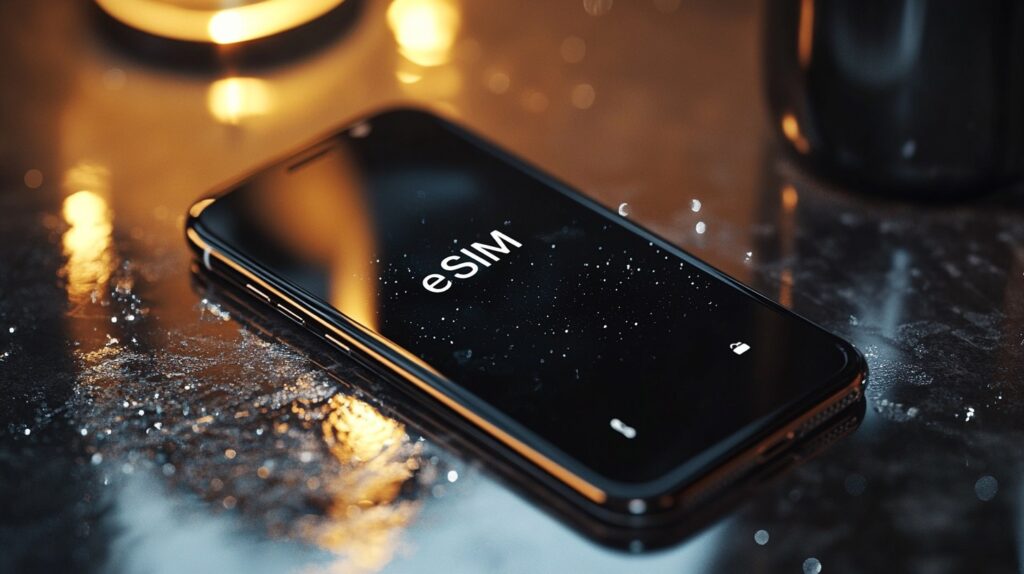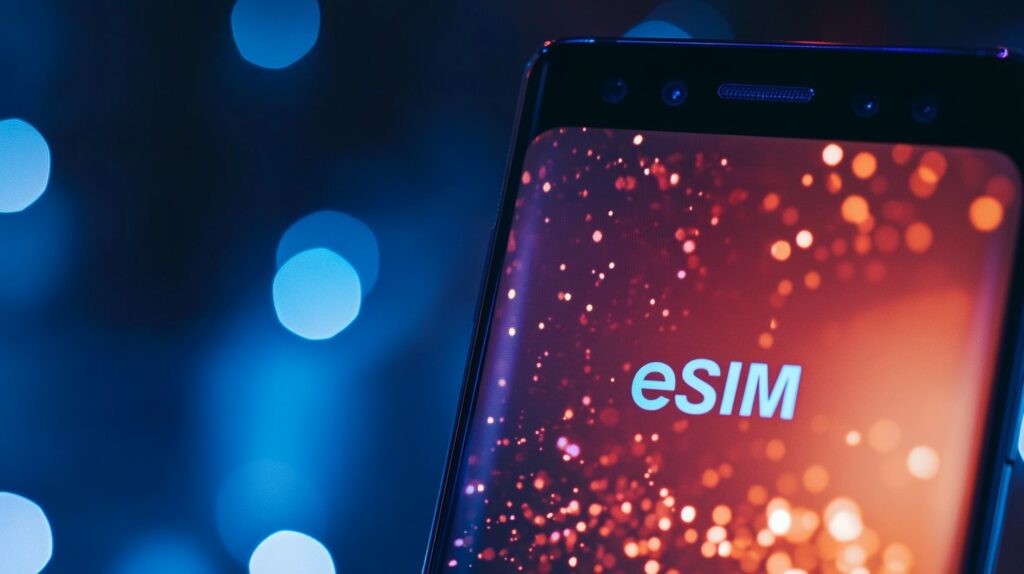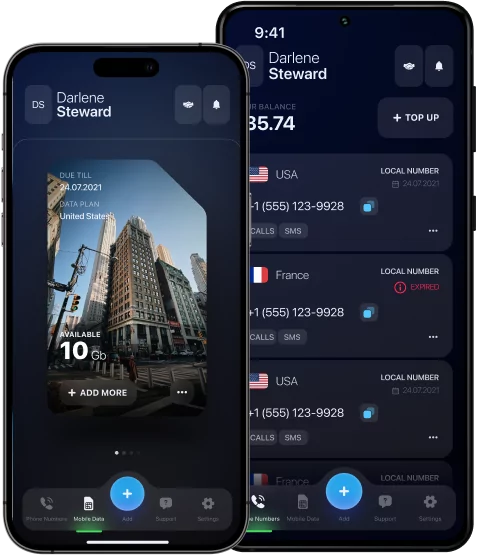How Many eSIMs Can You Have on Your Device?

In the modern world of mobile technologies, eSIM is no longer just a novelty but a real revolution. Thanks to virtual SIM cards, you can easily switch between operators, use multiple numbers on the same device, and even forget about having to carry bulky plastic cards with you.
The amount of eSIM in the phone depends on the device manufacturer and storage capacity. But how many eSIMs can you have on a phone? Does the quantity differ from the OS used by the phone?
Let’s consider this topic to understand the exact number of eSIMs.
What is an eSIM? Understanding the Basics
eSIM is a technology of embedded SIM cards that allows using multiple numbers in one device. eSIM does not require physical replacement to activate mobile operators. Instead, information about the network is digitally uploaded.
Look at several key advantages of using multiple eSIMs:
- Flexibility and freedom of choice. You can easily switch between eSIM numbers, and enable and disable them as needed.
- Ease of use. eSIM rates are stored digitally on the device, so you don’t need to carry physical SIM cards with you.
- Saving time and money. You can save eSIM rates for frequently visited countries so as not to overpay for roaming.
- Durability. eSIM eliminates the risks of physical damage to the SIM card and possible losses.
- Versatility. You can set different eSIMs to travel to different countries or use regional or global eSIMs.
The eSIM technology simplifies and improves the use of mobile networks, especially in conditions of constant movement and technology updates.

How Many eSIMs Can You Have on an iPhone?
– How many eSIMs can you have on one phone?
The number of eSIM accounts that can be added to one device depends on the manufacturer and model of the device. As a rule, modern smartphones can support 5 to 10 eSIM profiles.
However, do not forget that only one eSIM account can be active. That is, you can add up to 10 eSIM accounts on one device, without using them simultaneously. You will need to switch eSIM profiles in the settings.
In addition, there are some limits to adding eSIM profiles to a single device: hardware, software, and operator restrictions.
Hardware restrictions include limits on the number of profiles for simultaneous use.
Software restrictions include certain measures to limit the time of active use of the eSIM profile.
Operator restrictions narrow the allowed number of valid profiles and support the presence of one active eSIM profile.
Thus, modern devices allow storing multiple eSIM-compatible accounts on one device. However, there are a number of limitations for their simultaneous use.
iPhone eSIMs
– How many eSIMs can you have on iPhone?
All iPhone devices starting with the XS and XR models can support up to 5 eSIM profiles. At the same time, only 1 can be activated and used. To switch between tariffs and activate them, you will need to go to the device settings.
Here is an instruction on how to add eSIM or dual eSIM on iPhone:
Step #1: Open Settings → Carrier or Mobile Data → Add eSIM.
Step #2: Scan a QR code received from an eSIM provider, and follow the instructions.
Following these instructions, you can add new eSIM profiles on iPhone devices.

Android eSIMs
– How many eSIMs can you have on Android?
The number of profiles available for adding eSIM on Android devices is significantly less. Basically, it varies by manufacturer and model.
Here are examples of features for eSIM in the most popular Android device models.
- Google Pixel 7 and 7 Pro. Support up to 5 eSIM profiles. Only one is active at a time.
- Samsung Galaxy S23 and S23 Ultra. Support up to 3 eSIM profiles. Two eSIMs are active at the same time: main and additional.
- OnePlus 11. Supports up to 5 eSIM profiles. Only one is active at a time.
Here is a general instruction on how to add eSIM to Android:
Step #1: Open Settings → Internet Network → Carrier Data → Add eSIM.
Step #2: Scan a QR code received from an eSIM provider, and follow the instructions.
Following these instructions, you can add new eSIM profiles on Android devices.
How to Switch Between eSIMs
Here is an instruction on how to switch between eSIM profiles on iPhone:
Step #1: Open Settings → Mobile Data → eSIM.
Step #2: Choose an eSIM you want to activate and confirm the activation.
Here is an instruction on how to switch between eSIM profiles on Android:
Step #1: Open Settings → Internet Network → Mobile Data → eSIM.
Step #2: Choose an eSIM you want to activate and confirm the activation.
Next, let’s look at how to simplify the switching process and minimize possible problems.
- Clear organization. For ease of switching, name each eSIM profile, for example, “Work”, or “Home”. This will help simplify the search for the required profile.
- Creating a backup. To avoid losing information in case of failures and problems, create a backup of all necessary information.
- Checking the work. After switching between eSIM profiles, it is recommended to restart the device for the correct operation.
- Software update. Do not forget to update your smartphone’s software regularly to avoid possible problems with operation or compatibility with eSIM technology.
These steps will help make the process of switching between eSIM profiles smoother and more reliable.
Factors Influencing the Number of eSIM You Can Have
There are several factors that can affect the available number of eSIM profiles on a single device. Here is a list of the main ones:
- The phone model. Different smartphone models are equipped with a different list of technical capabilities. So one phone supports 5 eSIM, while the other only supports 2–3.
- Operator restrictions. Mobile operators may impose restrictions on the use of multiple eSIM profiles.
- OS limitations. The version of the OS used by the user on the smartphone may also limit the functionality and availability of eSIM profiles.
- Regional restrictions. In some countries and destinations, eSIM is banned, or there are some restrictions on the number of used eSIM profiles.
These are the main factors that determine the acceptable number of eSIM profiles to use on a single device.
Benefits of Having Multiple eSIMs on a Single Device
Despite the extensive list of advantages of using eSIM technology in principle, there are several important advantages of using multiple eSIMs:
- Access to local tariffs. When traveling abroad, the user can activate local mobile tariffs, thereby saving on expensive roaming.
- Separation of numbers. Multiple eSIMs make it possible to differentiate between work and personal numbers, thereby improving the organization and management of mobile communications.
- Cost optimization. Using multiple eSIMs makes it possible to select and manage tariff plans, thereby optimizing the cost of calls, SMS messages, and the internet.
These are the main advantages of adding multiple eSIMs, which make eSIM technology even more flexible and cost-effective.
Tips for Choosing the Best eSIM Provider
To choose a proven and trusted eSIM service, you need to pay attention to such details as:
- Network coverage. Before choosing, check the operator’s coverage map. The operator must maintain the required region, as well as a stable connection there.
- Prices. Browse through several providers and compare prices for services. Take into account the number of available calls, SMS, and internet traffic.
- Supported countries. If you are planning a trip, make sure that the provider works in that country.
- Additional functions. View the list of additional services and features.
- Tech support. Check the speed of the service’s technical support and real help in case of difficulties.
These criteria will help you choose the eSIM provider that best suits your needs and preferences.

How to Get Started with eSIM Plus
For an ordinary person, eSIM technology may seem complicated but in fact, it is a very simple and convenient technology that provides mobile communications almost all over the world.
If you still don’t know how to smoothly switch to eSIM technology, then here are some working tips that will help you do it quickly and without regret:
- Check the device compatibility with eSIM technology.
- Contact mobile carrier about adding eSIM.
- Choose the eSIM provider if your mobile operator didn’t provide the technology.
- Download the needed app for eSIM activation.
- Activate and set up all eSIM functions.
- Test the correct work of eSIM on your device.
These are the simplest steps to implement eSIM technology in everyday life. To make the process as smooth as possible and not problematic, choose eSIM Plus — a convenient service with fast activation and a whole set of useful features.
Choose eSIM Plus and easily manage multiple eSIM plans by switching between them and enjoying the flexibility they offer.





